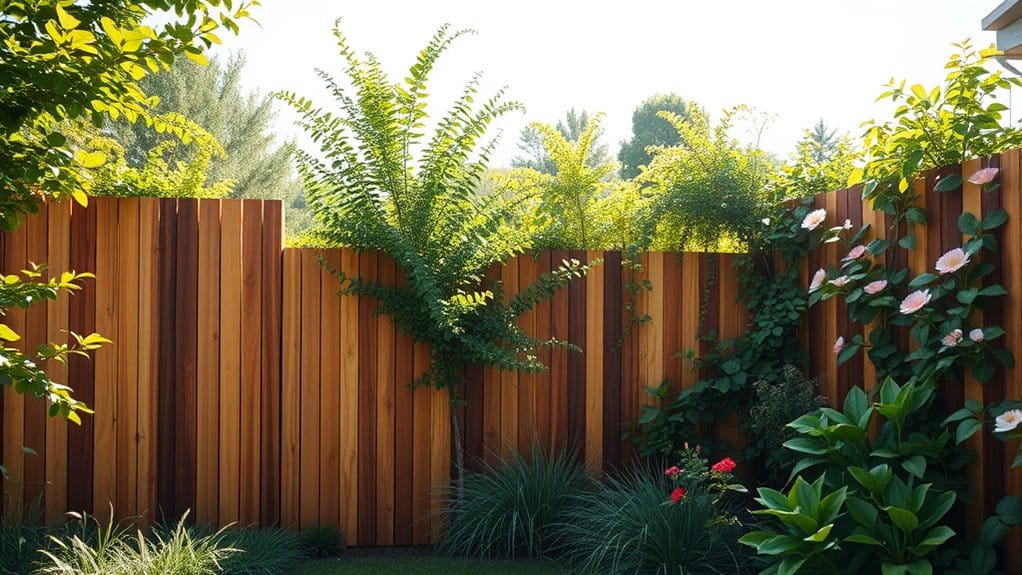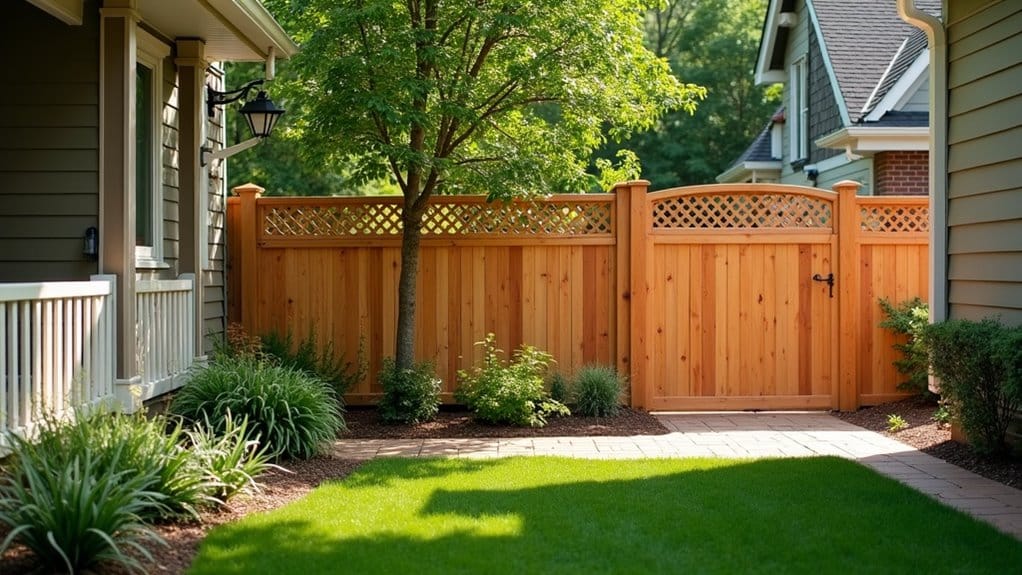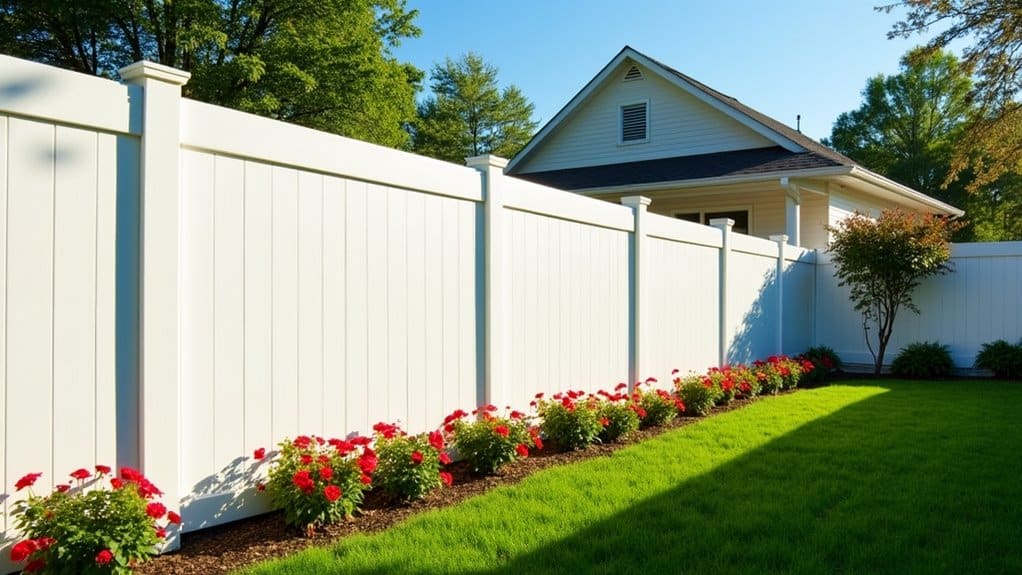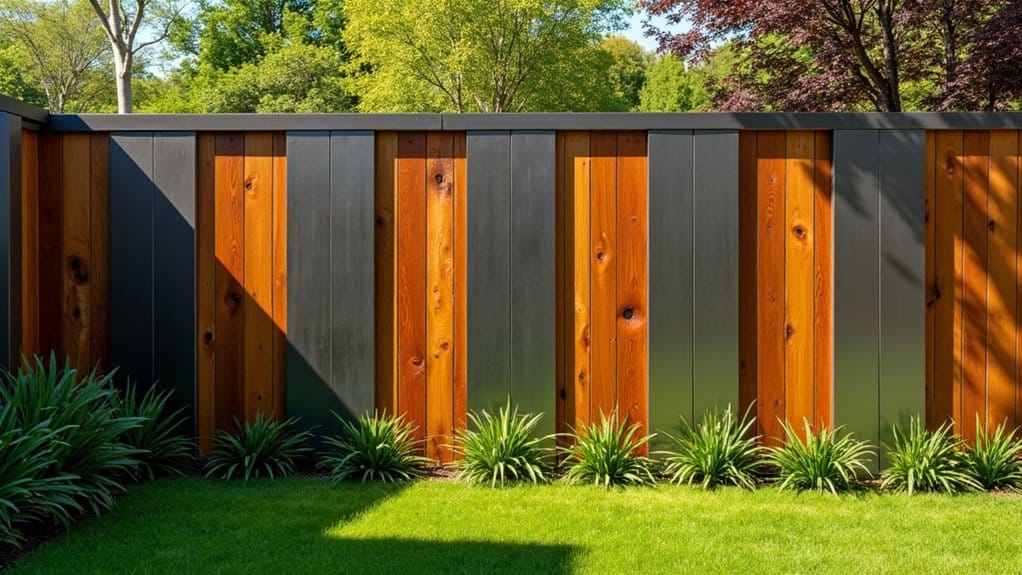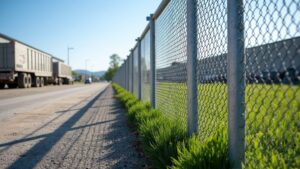For reducing heat and noise, consider energy-efficient fencing made from sustainable materials like bamboo or recycled plastics. These options not only enhance your property's look but also help lower your carbon footprint. Taller, heavier materials like brick or wood can provide better soundproofing, so be sure to seal any gaps. Light-colored fences reflect sunlight, keeping your space cooler, while adding greenery or climbing plants offers natural insulation. A combination of composite panels and metal posts can create a low-maintenance solution. Explore these strategies to effectively improve your environment.
Key Takeaways
- Taller Fences: Opt for taller fences to effectively block noise and shield your property from direct sunlight.
- Mass-Loaded Vinyl: Use mass-loaded vinyl in your fencing for better sound absorption and temperature control.
- Heavy Materials: Choose robust materials like brick or precast concrete for superior soundproofing and thermal stability.
- Greenery: Incorporate climbing plants or green walls to provide natural shade and enhance noise reduction.
- Layered Barriers: Design double barriers or angled fences to improve sound blocking and minimize heat buildup.
Eco-Friendly Fencing Materials
When upgrading your fencing, consider eco-friendly materials to enhance your property's appeal and sustainability. Bamboo and recycled plastics are two excellent choices. Bamboo is a fast-growing, renewable resource that's strong, durable, and naturally resistant to termites, making it a great long-term solution. Additionally, bamboo is a renewable resource that regenerates quickly, ensuring a sustainable supply for future use. Recycled plastics, made from post-consumer waste, help reduce landfill contributions and are low-maintenance and highly resistant. The production process for these materials is energy-efficient, further supporting sustainability. Composite fencing, which combines recycled materials, is another durable option that requires minimal upkeep. By choosing bamboo or recycled plastics, you not only improve your property's look but also lower your carbon footprint and support responsible resource use. These eco-friendly fencing options can create a beautiful outdoor space that aligns with your environmental values while offering lasting benefits.
Effective Soundproofing Techniques
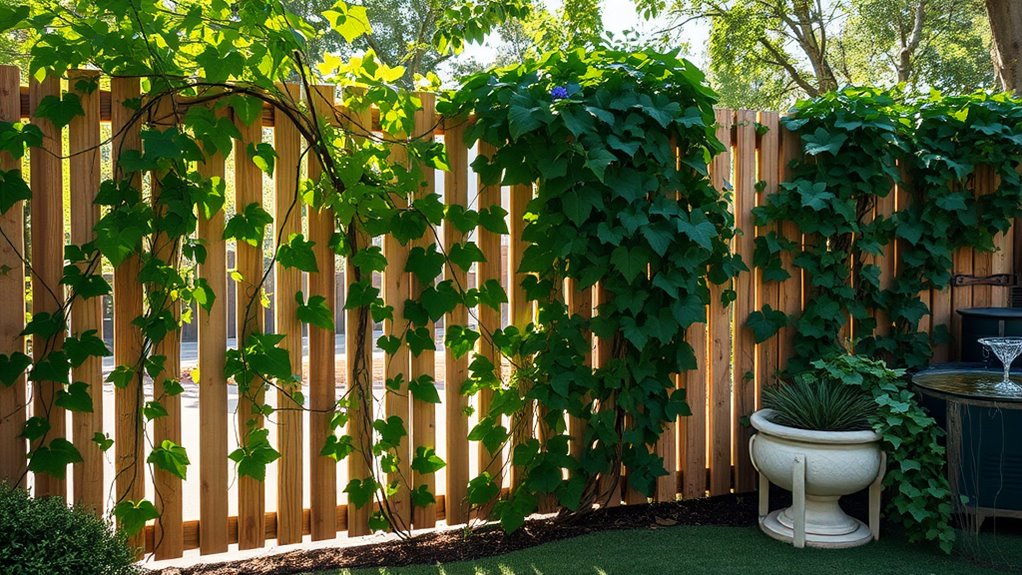
Choosing eco-friendly materials for your fence not only supports sustainability but also aids soundproofing. To effectively reduce noise, opt for taller fences, as they block more sound. Positioning your fence closer to the noise source or receiver enhances its effectiveness.
For noise reduction, heavier materials like wood or brick are better than lighter options like chain link. Ensure your fence is airtight; any gaps will diminish its soundproofing abilities. Adding mass-loaded vinyl or acoustic insulation can help fill gaps and boost soundproofing. Additionally, using acoustic insulation products can significantly enhance your fence's ability to absorb sound. A well-designed fence can also provide privacy from neighbors, further enhancing your outdoor experience.
For optimal results, consider layering materials or using techniques like double barriers or tilting barriers, which can improve sound blocking by over 10 dB.
Regular maintenance is crucial to keep your fence performing well over time. With careful planning of your fence's design and materials, you can create an effective sound barrier that aligns with eco-friendly values.
Methods to Reduce Heat
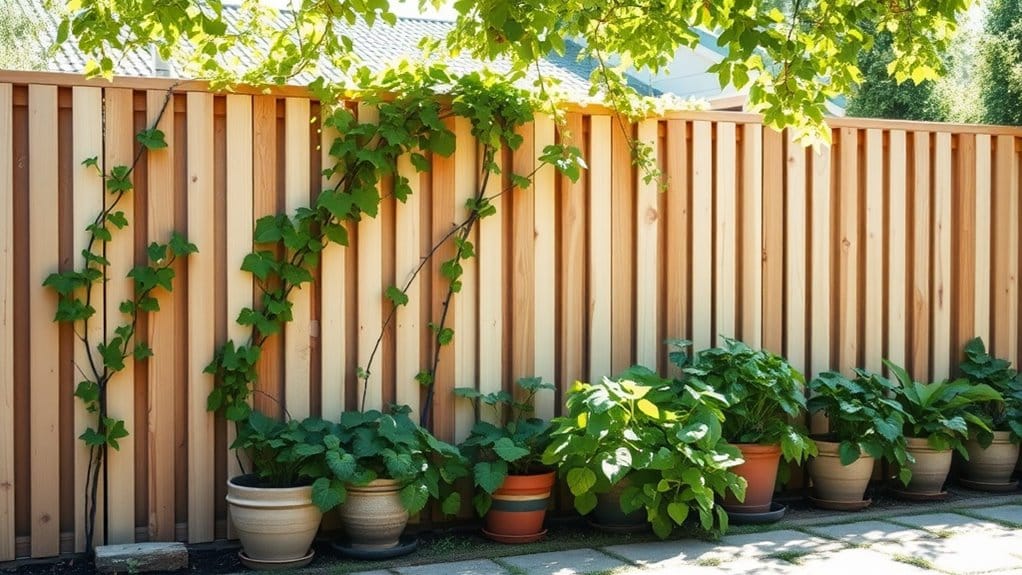
Reducing heat in outdoor spaces can improve your home's energy efficiency and comfort. One simple way to do this is by using light-colored fencing materials, which reflect sunlight and keep your property cooler in summer.
On the other hand, darker surfaces can retain warmth during colder months.
Fencing can also help adapt to climate changes. Materials like brick and concrete have high thermal mass, meaning they absorb heat and release it slowly, helping to stabilize temperatures. Additionally, high thermal mass materials can contribute to better evening comfort by moderating outdoor temperatures.
Placing your fence strategically can block direct sunlight from hitting your home's walls and windows, further reducing heat.
Adding greenery, such as climbing plants or green walls, not only looks good but also provides shade, helping to cool the area.
Additionally, consider the height and orientation of your fence to create windbreak effects, protecting your home from cold winds and reducing heating needs.
Durability of Fencing Materials
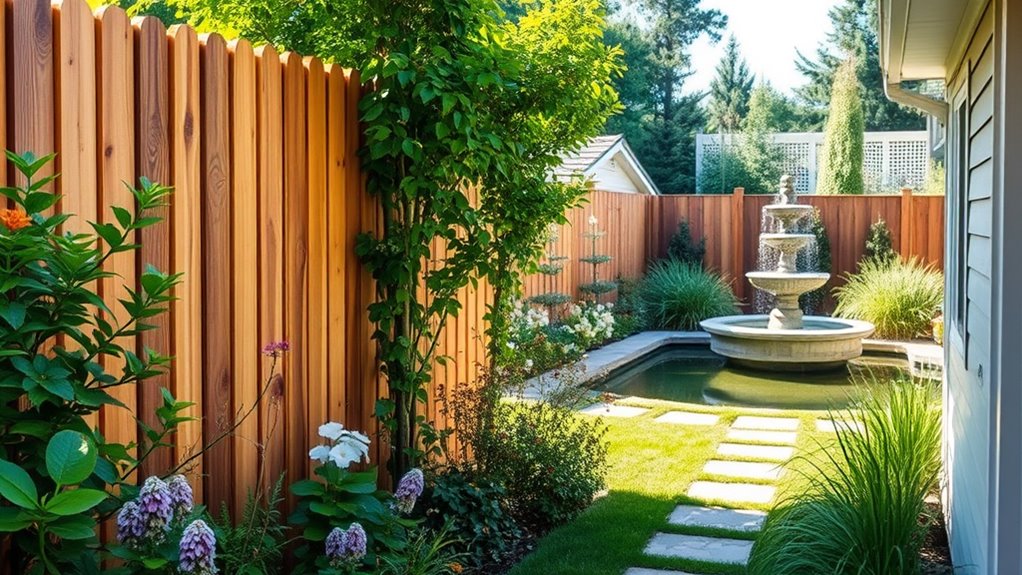
When selecting fencing materials, consider their longevity and resistance to weather.
Options like wood, metal, vinyl, and precast concrete vary in durability and maintenance needs. For instance, wood may require regular staining or painting, while vinyl is more maintenance-free. Understanding these differences will help you choose a fence that fits your needs and remains effective over time. Additionally, precast concrete fences can last between 50 to 100 years, making them an excellent choice for long-term durability. Furthermore, PVC fences are known for their resistance to termite damage, mildew, and rot, ensuring a long-lasting solution.
Material Longevity Factors
Wood Fences: With proper care, wood fences can last 10-20 years. Cedar is the most durable, lasting 15-30 years, while spruce and pine have shorter lifespans.
Regular maintenance, like cleaning and staining, helps prevent rot and insect damage.
Vinyl Fences: These have a lifespan of 20-30 years and require minimal upkeep. They're resistant to rot and insects but can be damaged by impacts, such as car collisions. Opting for high-quality vinyl can boost durability. Additionally, PVC fencing offers long-term cost-effectiveness due to its durability and low maintenance.
Metal Fences: Wrought iron and steel fences can last 20-50 years or more with the right care. Using protective coatings, like powder coating, is crucial to prevent rust and warping.
Consider your needs and budget when selecting a fencing material to ensure you make a smart investment.
Resistance to Elements**
Choosing Fencing Materials That Resist the Elements
Selecting the right fencing materials can greatly extend the life and effectiveness of your fence. Look for options that resist corrosion and can handle extreme temperatures.
Galvanized wire fencing is a solid choice. Its zinc coating prevents rust, making it perfect for humid areas.
Another good option is vinyl-coated wire fencing, which combines strength with a weather-resistant finish. Additionally, thicker wire (lower gauge) can offer more strength and durability, making it an essential consideration for your fencing needs.
If you live near the coast, consider stainless steel fencing. It's durable and low maintenance, perfect for salty air.
Aluminum fencing is also a great choice; it develops a protective oxide layer that keeps it rust-free in harsh conditions.
For areas with significant temperature changes, vinyl fencing is ideal. It won't crack or warp in cold weather, ensuring it lasts longer.
Ultimately, choosing materials that resist corrosion and temperature extremes will keep your fence looking good and standing strong for years.
Making the right choice now can save you money on repairs later.
Energy Efficiency Advantages
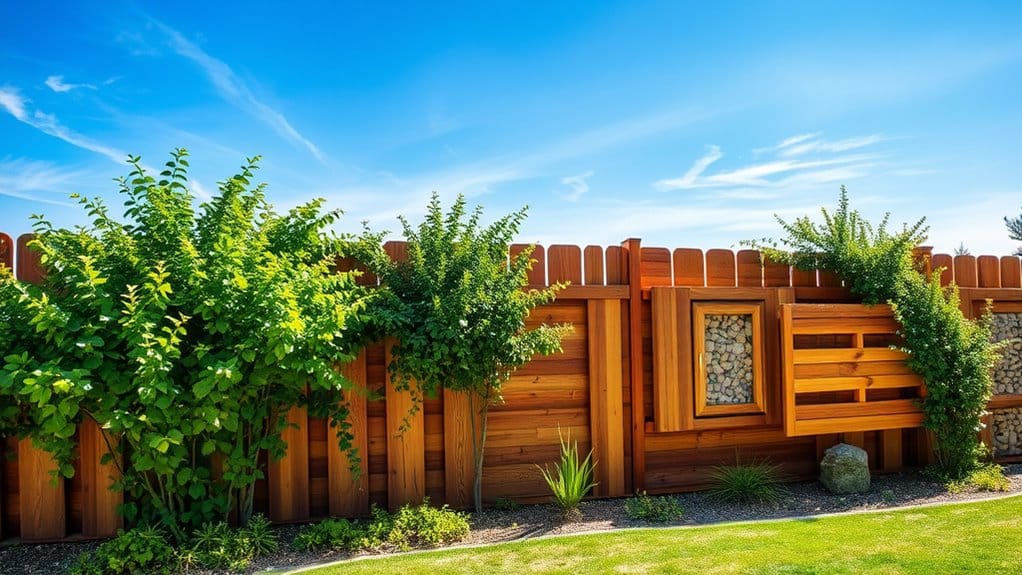
Choosing energy-efficient fencing not only boosts your property's appeal but also lowers your carbon footprint. Using sustainable materials and designs reduces environmental impact while saving you money over time due to their durability and low maintenance. Sustainable sourcing ensures that the materials used in your fencing have minimal impact on the environment, further enhancing their energy-efficient benefits. It's a smart choice for your wallet and the planet.
Carbon Footprint Reduction
Sustainable fencing options help reduce carbon footprints by using eco-friendly materials and manufacturing processes. Choosing materials like bamboo, recycled plastic, or reclaimed wood not only requires less energy to produce but also releases fewer greenhouse gases compared to traditional fencing. These sustainable choices support carbon offsetting by utilizing resources that absorb carbon dioxide and help prevent deforestation. Additionally, using materials such as vinyl fencing can provide long-lasting durability, reducing the need for replacements and further lowering environmental impact.
Using energy-efficient manufacturing methods, especially with recycled materials, further cuts down emissions. Locally sourced materials also reduce transportation emissions, which can significantly lower your carbon footprint. Additionally, the production of composite fencing typically involves lower energy inputs, contributing to overall energy savings.
Plus, incorporating recycled materials helps keep waste out of landfills and supports a circular economy. Durable materials like metal and bamboo need less maintenance and replacement, minimizing their environmental impact over time. Living fences, which include plants, enhance biodiversity and improve carbon sequestration in your yard.
Long-Term Cost Savings
Investing in energy-efficient fencing can lead to substantial long-term savings. By choosing the right materials and designs, you can boost your property's value and lower your expenses. For instance, solar panel fences not only act as barriers but also produce energy, which can help cut down on electricity bills. These systems typically provide a return on investment (ROI) within 8-12 years. Additionally, solar electric fences operate using solar energy, even at night with battery storage, making them versatile for remote areas and sustainability efforts. Furthermore, utilizing durable materials like aluminum can further enhance the longevity and cost-effectiveness of your fencing choice.
Here's a quick look at different fencing options and their benefits:
| Fencing Type | Long-Term Benefits |
|---|---|
| Aluminum Fences | Cost-effective, low maintenance |
| Eco-Friendly Fences | Durable and energy-efficient |
| Solar Panel Fences | Generates energy, lowers bills |
| Bifacial Solar Fences | Higher energy output, space-saving |
Choosing energy-efficient fencing is more than just a purchase; it's a smart investment. It can lead to a healthier environment and significant savings over time, supporting your budget while enhancing your property's functionality.
Installation and Setup Tips
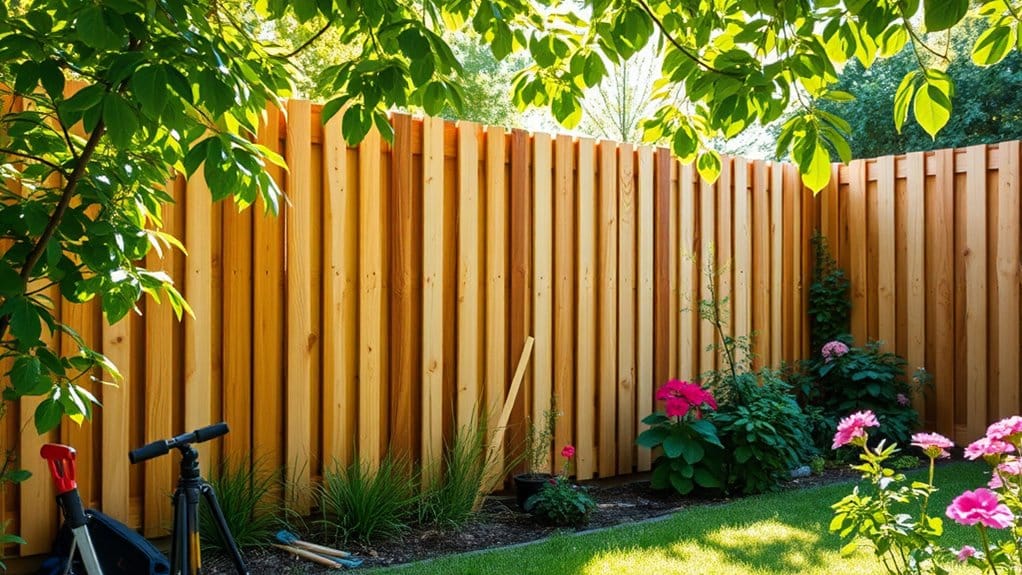
To install an energy-efficient fence, start with careful planning. Clear any debris from the area and check your property lines to prevent disputes. Measure the perimeter for post spacing and mark where the posts will go. Don't forget to contact utility services before you dig to ensure safety.
When digging, use a post hole digger to create holes that are one-third the height of your fence. Set the posts in the holes and fill them with concrete, making sure they're level. Allow the concrete to cure fully before moving on. Installing posts with gravel bases promotes drainage and enhances the longevity of your fence.
Once the posts are secure, attach the rails using nails or screws. For even spacing, consider using U-jigs or cleats. If you're using prefabricated panels, make sure they're tightly secured to the posts.
Finally, trim the rails to size and pre-stain the ends for extra durability. Following these steps will help you build a sturdy, energy-efficient fence that effectively reduces heat and noise.
Combining Materials for Success
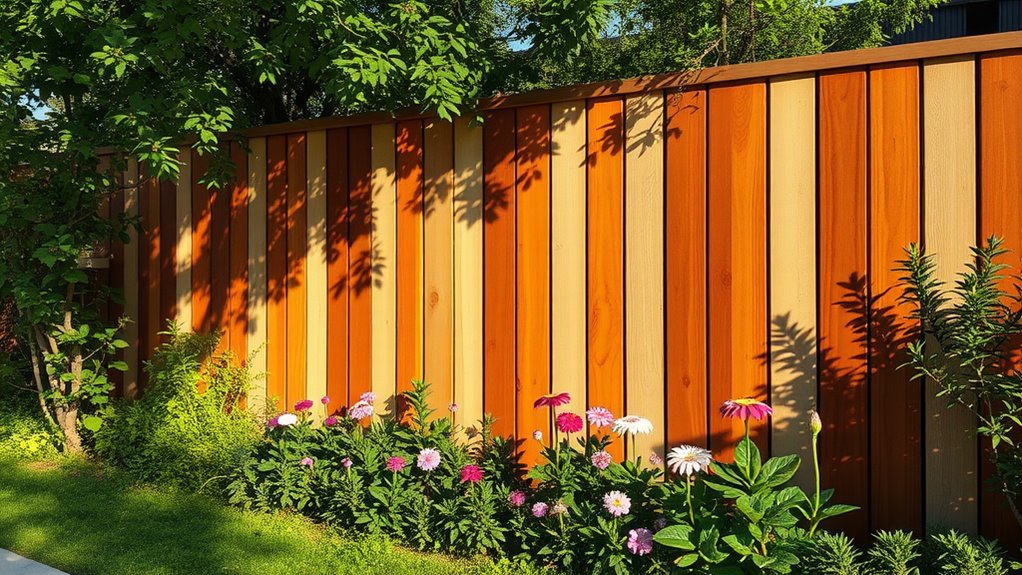
When choosing an energy-efficient fence, combining materials can boost durability and appearance. For example, pairing bamboo slats with a metal frame creates a sustainable and strong option that withstands harsh weather while looking great.
Mixing composite panels with metal posts offers a robust, weather-resistant fence that needs little upkeep. If privacy is a priority, adding bamboo slats to chain link fencing provides an elegant and eco-friendly solution.
Consider using recycled wood with aluminum for an environmentally friendly and durable choice. Additionally, combining sustainably sourced wood with metal accents gives your fence a modern, stylish edge.
Overall, blending materials can result in a functional and visually appealing fence, helping you achieve energy efficiency while enhancing your property's look.
Keep these ideas in mind as you plan your perfect fencing solution.
Strategic Fencing Placement
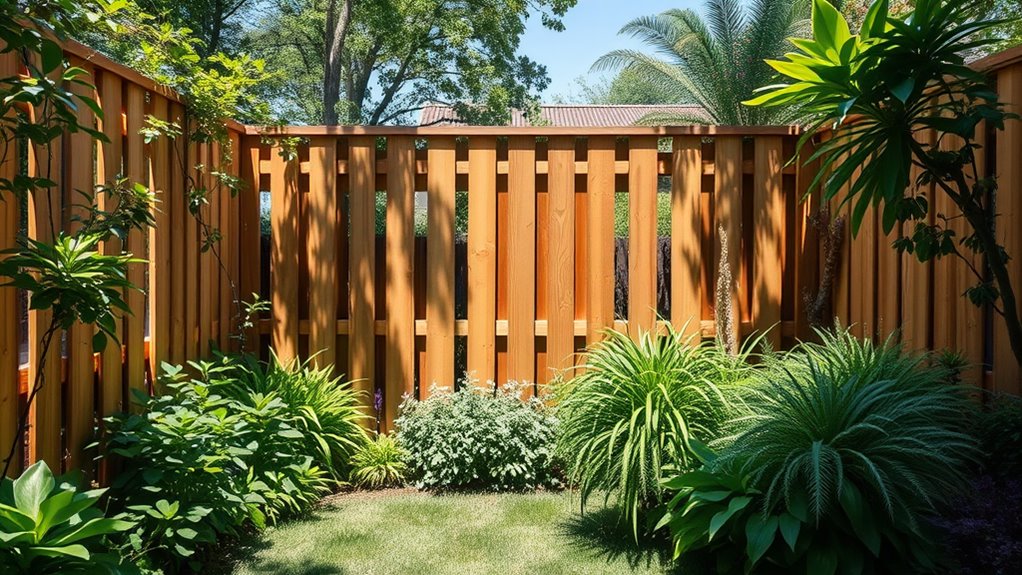
Placing your fence wisely can boost energy efficiency and comfort in your outdoor spaces. Pay attention to the fence's orientation and its interaction with sunlight and wind. For example, a well-placed fence can block cold winter winds and absorb heat if made from dark materials. In the summer, it can create shade, helping to cool your property.
When planning, think about how your fence can create microclimates. It can regulate temperature, reduce soil erosion, and support plant growth. Adding climbing plants or green walls can enhance cooling effects, making the environment more pleasant.
Also, consider local climate factors like wind and sunlight. Light-colored fences reflect sunlight, keeping areas cooler, while materials like brick or concrete can store heat and moderate temperatures throughout the day.
Long-Term Maintenance Considerations
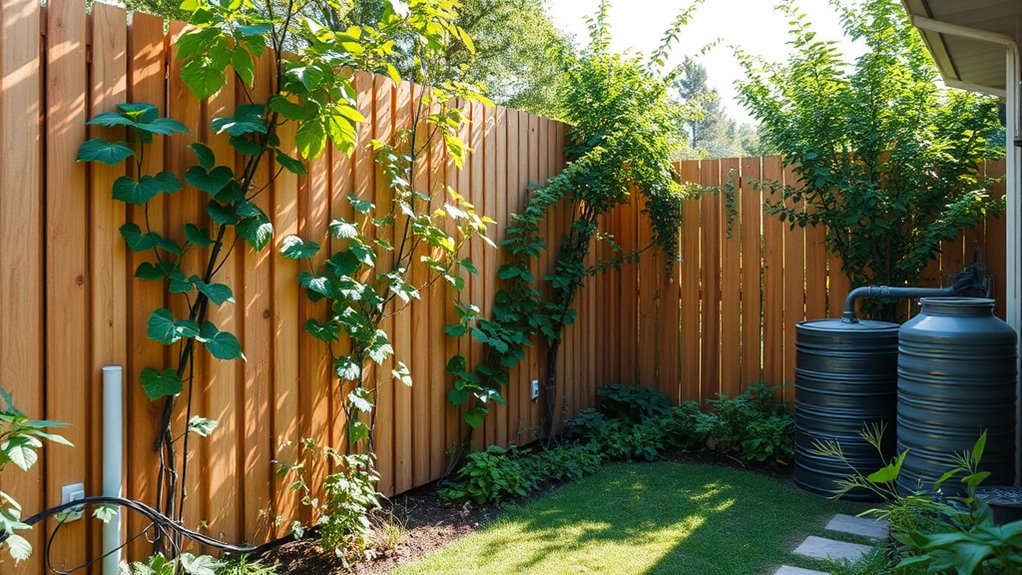
Maintaining your fence is essential for its longevity and performance. Start by creating a maintenance schedule based on your fence material. For example, aluminum and composite fences require little upkeep, while wood fences need regular checks, sealant applications, and cleaning to prevent rot and UV damage.
Address any damage promptly to avoid worsening issues. For wood fences, replacing rotted boards or refreshing protective coatings can significantly extend their lifespan.
Vinyl fences need occasional cleaning and crack checks, while bamboo fences should be inspected for termites.
Proper installation is also crucial for long-term maintenance. If you installed the fence yourself, ensure the foundation is stable and the materials are of high quality.
Frequently Asked Questions
How Can I Choose the Best Fencing Style for My Home?
To choose the best fencing style for your home, think about how it looks and how much privacy you want. Look at your yard's size, the materials available, and any neighborhood rules. For example, a tall wood fence can offer privacy, while a decorative picket fence adds charm. Make sure your fence fits your space and meets your needs.
What Permits Are Required for Installing a Fence?
Before installing a fence, it's crucial to check your local regulations. Depending on factors like the height, material, and location of your fence, you may need a permit. For example, some areas require permits for fences over six feet tall or made of specific materials. Always verify the requirements in your area to prevent fines or having to remove your fence later.
How Does Climate Affect Fence Material Choice?
Climate plays a crucial role in choosing fence materials. For instance, in humid areas, metals can rust, while wood may warp when exposed to moisture. Picking the right material ensures your fence lasts longer and withstands local weather conditions.
Can I Paint Eco-Friendly Fencing Materials?
Yes, you can paint eco-friendly fencing materials with eco-friendly paints. Choose low or zero VOC paints to minimize environmental impact while improving your fence's look and durability.
What Is the Average Lifespan of Different Fencing Materials?
Vinyl fences can last up to 40 years with little maintenance. In comparison, wood fences need more care, while metal fences are durable but require regular upkeep to stay in good shape.
Conclusion
Energy-efficient fencing can significantly improve your home's comfort and sustainability. For example, well-placed fencing can cut noise pollution by up to 50%. By choosing eco-friendly materials and soundproofing techniques, you can reduce heat loss and create a quieter outdoor space. Proper installation and maintenance are key to maximizing these benefits, ensuring your fencing is both attractive and energy-efficient.

